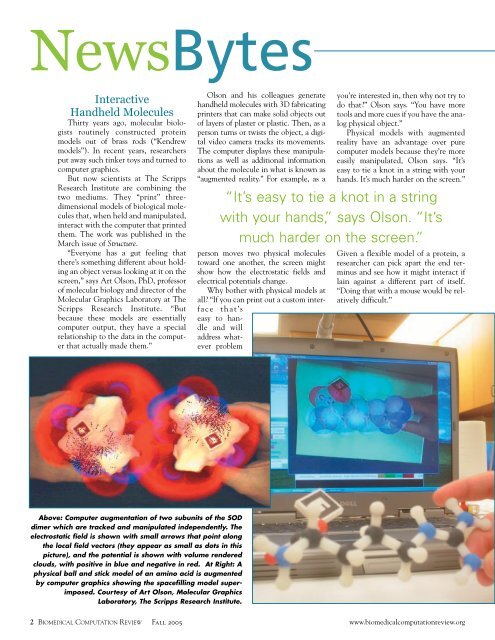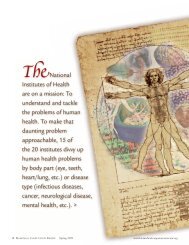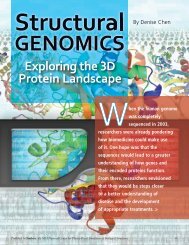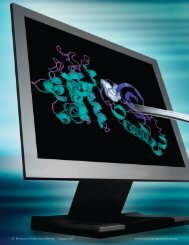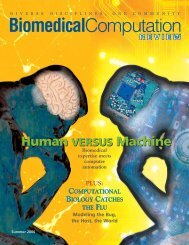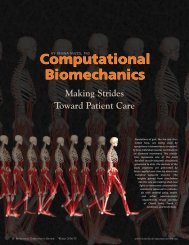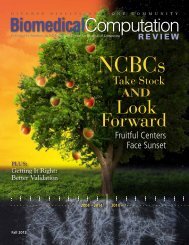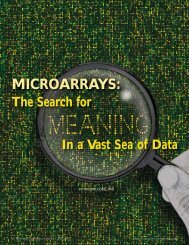NewsBytesInteractiveHandheld MoleculesThirty years ago, molecular biologistsroutinely constructed proteinmodels out of brass rods (“Kendrewmodels”). In recent years, researchersput away such tinker toys and turned tocomputer graphics.But now scientists at The ScrippsResearch Institute are combining thetwo mediums. They “print” threedimensionalmodels of biological moleculesthat, when held and manipulated,interact with the computer that printedthem. The work was published in theMarch issue of Structure.“Everyone has a gut feeling thatt<strong>here</strong>’s something different about holdingan object versus looking at it on thescreen,” says Art Olson, PhD, professorof molecular biology and director of theMolecular Graphics Laboratory at TheScripps Research Institute. “Butbecause these models are essentiallycomputer output, they have a specialrelationship to the data in the computerthat actually made them.”Olson and his colleagues generatehandheld molecules with 3D fabricatingprinters that can make solid objects outof layers of plaster or plastic. Then, as aperson turns or twists the object, a digitalvideo camera tracks its movements.The computer displays these manipulationsas well as additional informationabout the molecule in what is known as“augmented reality.” For example, as aperson moves two physical moleculestoward one another, the screen mightshow how the electrostatic fields andelectrical potentials change.Why bother with physical models atall? “If you can print out a custom interfacethat’seasy to handleand willaddress whateverproblemyou’re interested in, then why not try todo that?” Olson says. “You have moretools and more cues if you have the analogphysical object.”Physical models with augmentedreality have an advantage over purecomputer models because they’re moreeasily manipulated, Olson says. “It’seasy to tie a knot in a string with yourhands. It’s much harder on the screen.”“It’s easy to tie a knot in a stringwith your hands,” says Olson. “It’smuch harder on the screen.”Given a flexible model of a protein, aresearcher can pick apart the end terminusand see how it might interact iflain against a different part of itself.“Doing that with a mouse would be relativelydifficult.”Above: Computer augmentation of two subunits of the SODdimer which are tracked and manipulated independently. Theelectrostatic field is shown with small arrows that point alongthe local field vectors (they appear as small as dots in thispicture), and the potential is shown with volume renderedclouds, with positive in blue and negative in red. At Right: Aphysical ball and stick model of an amino acid is augmentedby computer graphics showing the spacefilling model superimposed.Courtesy of Art Olson, Molecular GraphicsLaboratory, The Scripps Research Institute.2 BIOMEDICAL COMPUTATION REVIEW Fall 2005 www.biomedicalcomputationreview.org
The physical models might alsoprove valuable as talking devices whenstructural biologists collaborate withscientists who don’t routinely thinkabout structure, Olson says. Andadding augmented reality to physicalmodels may prove helpful in explainingcomplex concepts to students. In earlytests, one thing is for sure, says Olson,“The students like it better.”Bacteria with ByteWhen a bacterium swims towardfood, it follows a chaotic path, alternatingbetween spinning randomly anddriving forward, or ‘tumbling’ and ‘running.’Computer scientists at theUniversity of Chicago have now createda virtual colony of E. coli bacteria—complete with digital receptors,motors, and signaling pathways—thatrun and tumble just like real bacteria.The simulation program, AgentCell,is the first to model a biochemical networkat the molecular, single cell, andpopulation levels simultaneously. Bydoing so, it might provide a frameworkfor modeling other biological systems,including cancer and antibacterialresistance. AgentCell was introduced inthe June 1 issue of Bioinformatics.www.biomedicalcomputationreview.orgDigitalE. coli swimrandomly ina nutrientfreemedium(green cells)or up agradientof nutrient(red cells).Solid redand greenlines indicateaveragepositionof eachpopulation.Courtesyof ThierryEmonet.“We usedAgentCell’schemotaxis network, but you can usethe program for any kind of networkyou want,” says Thierry Emonet, PhD,a research scientist at the University ofChicago and lead author on the paper.AgentCell uses agent-based simulation,a type of software developed tomodel social behavior, such as thestock market. An agent is a softwareobject that makes completelyautonomous decisions. InAgentCell, each single-celledbacterium decides to run ortumble based on input fromthe virtual environment andfluctuating intracellular signals.The program models thebehavior of thousands of bacteriaacting independently.Future versions will allow thebacteria to interact.The researchers used bacterialchemotaxis as a test-bedfor AgentCell because it is oneof the best characterized systemsin biology. An E. coli bacteriumswims toward nutrients and away frompoisons by alternating the rotation ofits flagella: counterclockwise motioncauses flagella to bundle into a tightpropeller (running); clockwise motioncauses the flagella to fly apart (tum-bling). Chemical signals in the bacteriacontrol the switch between run andtumble, but the mechanism is noisy:the frequency of switching is highlyvariable between two genetically identicalcells in the same environment.Using AgentCell, Emonet hopes tobetter understand how cells make decisionsin the face of such variability.Chemotaxis is super-simple decisionmaking;a more complicated decisionfor a cell is whether or not to divide,Emonet says. When customized,AgentCell could be used to study howcell division goes awry in cancer.Computer simulations can testcompeting theoretical models andguide future lab experiments. In thelab, it takes months to grow cells witha mutated protein. In the computer, ittakes just a quick and elegant changeof the code.AgentCell will soon be available asopen access code on the website:www.agentcell.org. “We’d love to havepeople grabbing the code and addingmodules, adapting it to their ownneeds,” Emonet says.“Because of its modular architecture,the system readily integrates preexistingsimulators and algorithms withvery little development overhead,” saysIn the lab, it takes monthsto grow cells with a mutatedprotein. In the computer,it takes just a quick andelegant change of the code.Tom Schmizu, a post-doctoral fellowat Harvard University. For example,you could easily swap in your ownfavorite model of intracellular signalingor of receptor binding intoAgentCell, and then test it againstdata from the real world. >Fall 2005 BIOMEDICAL COMPUTATION REVIEW 3


